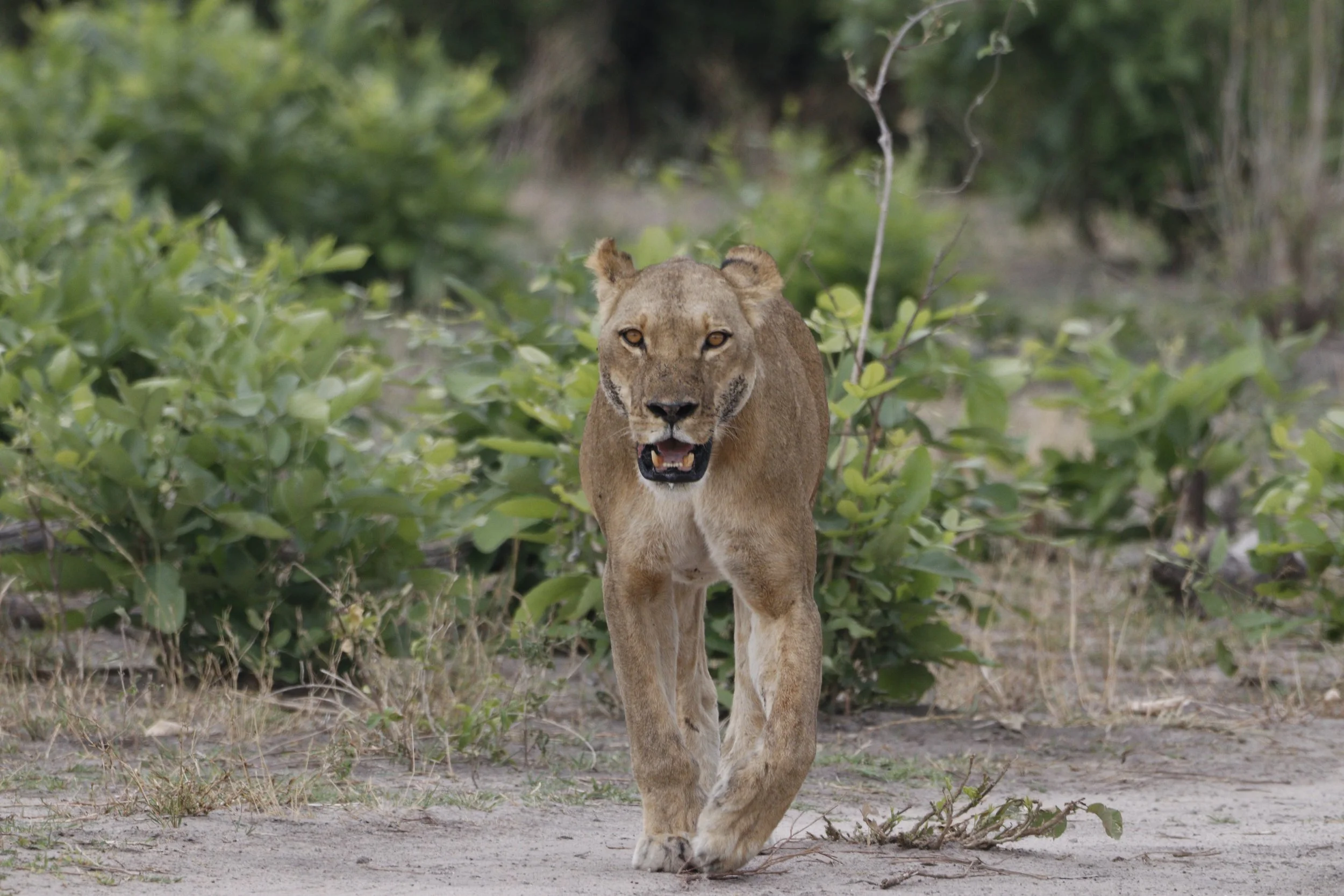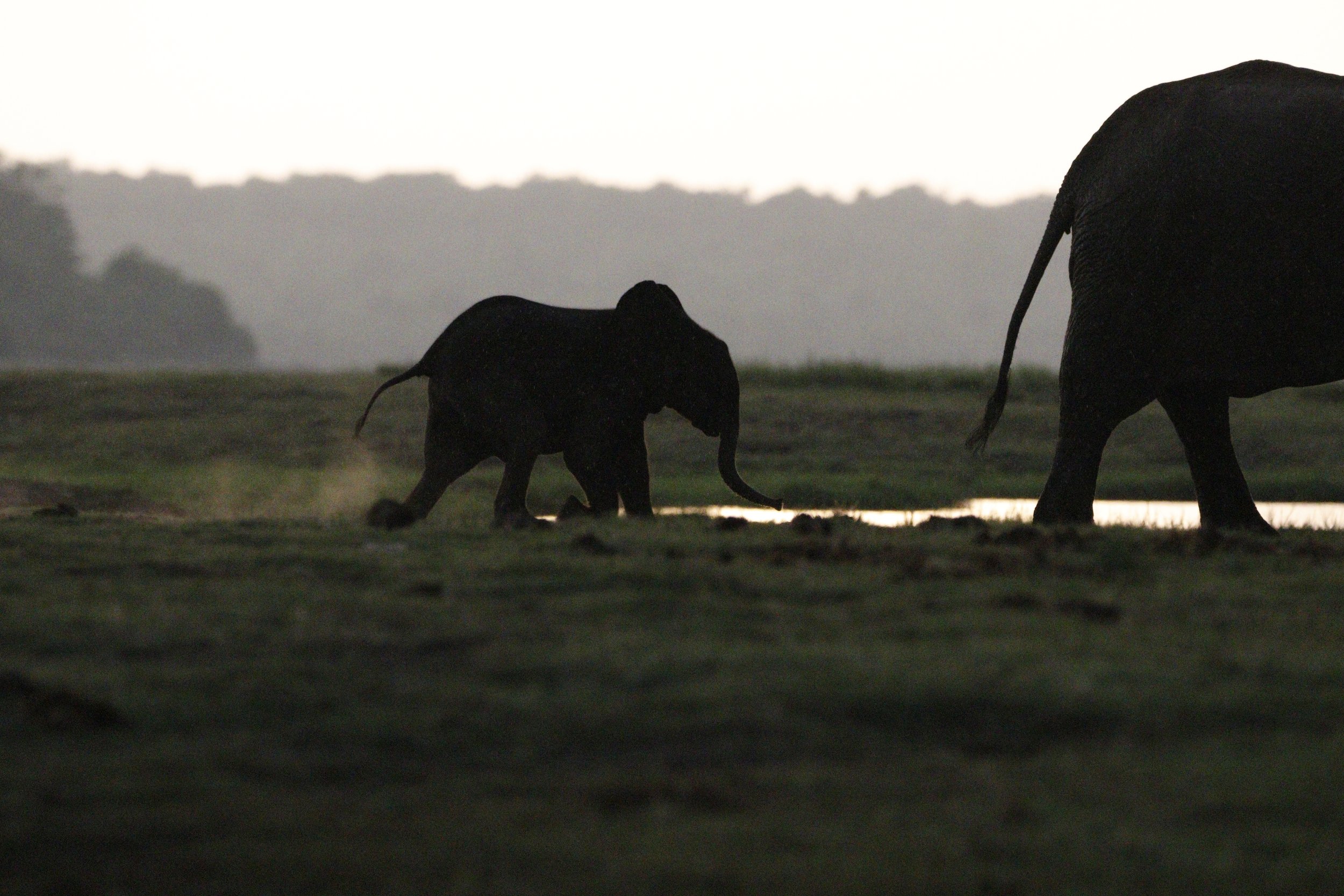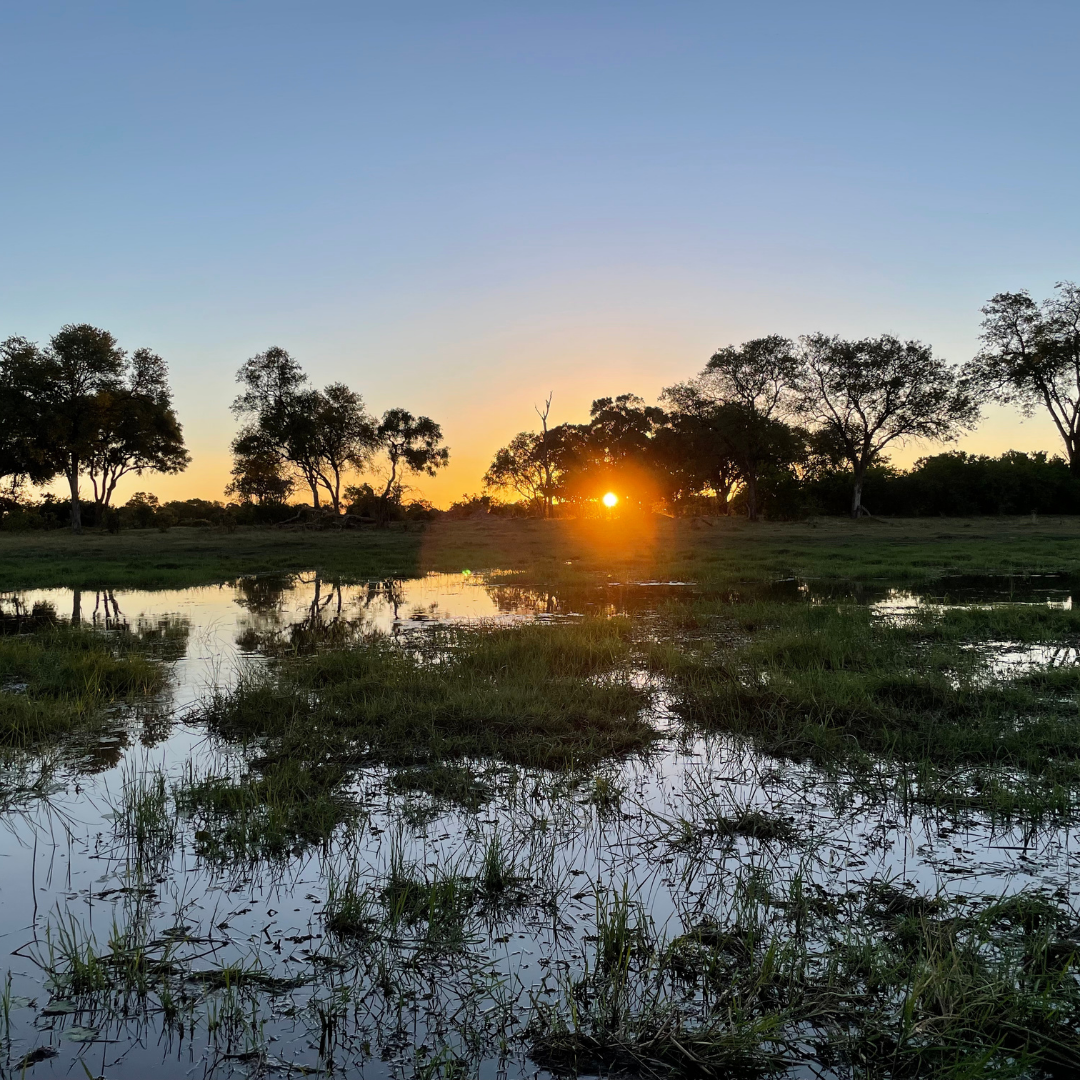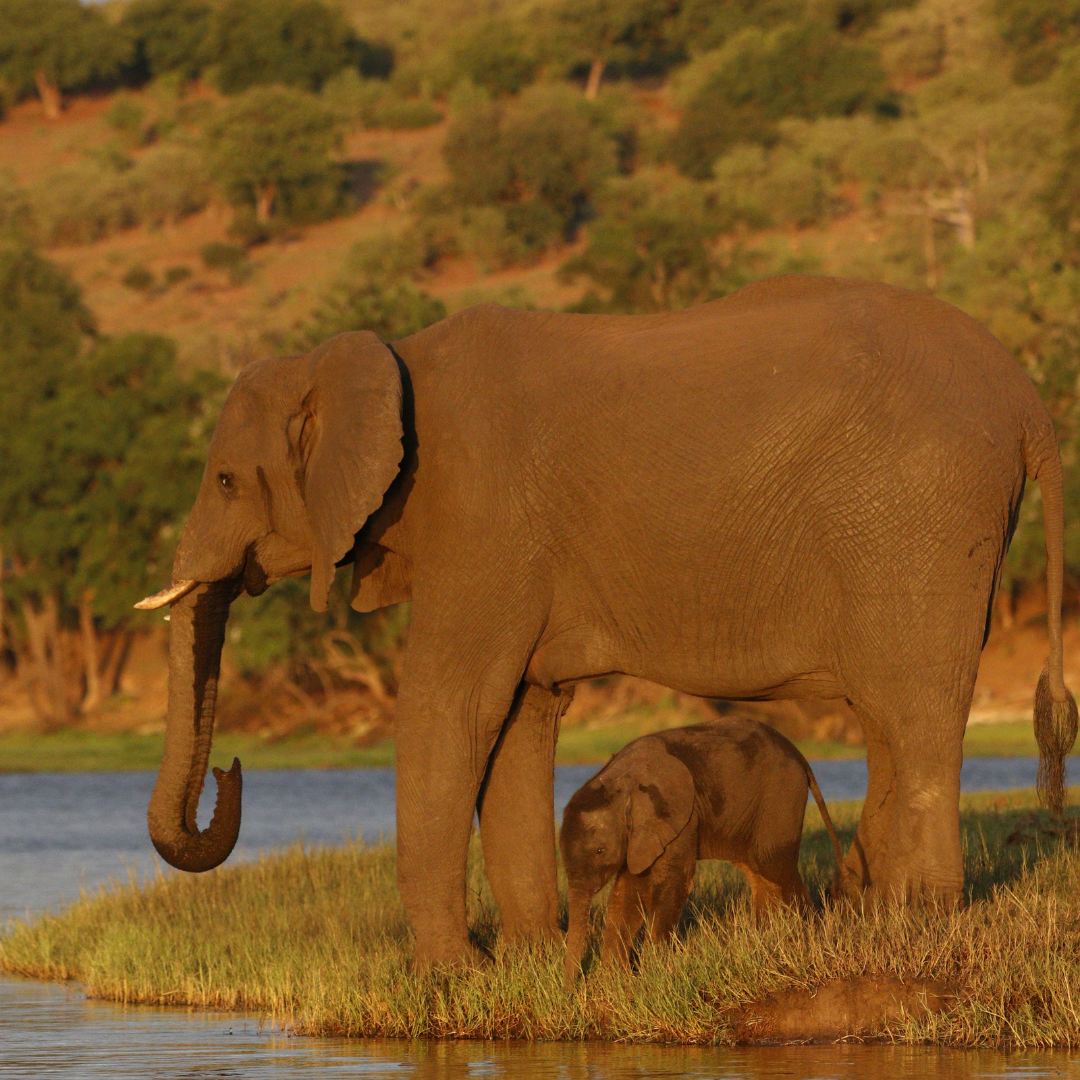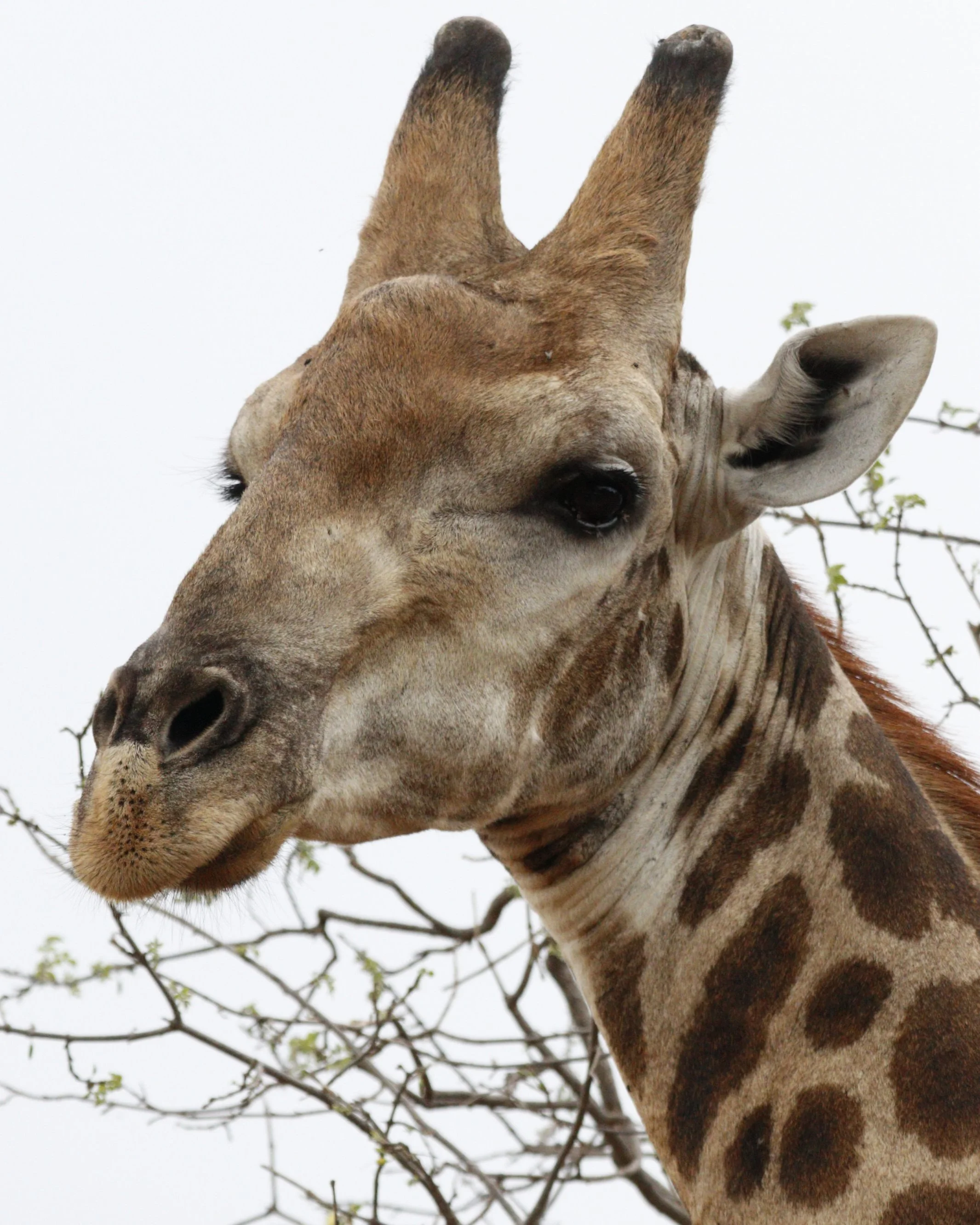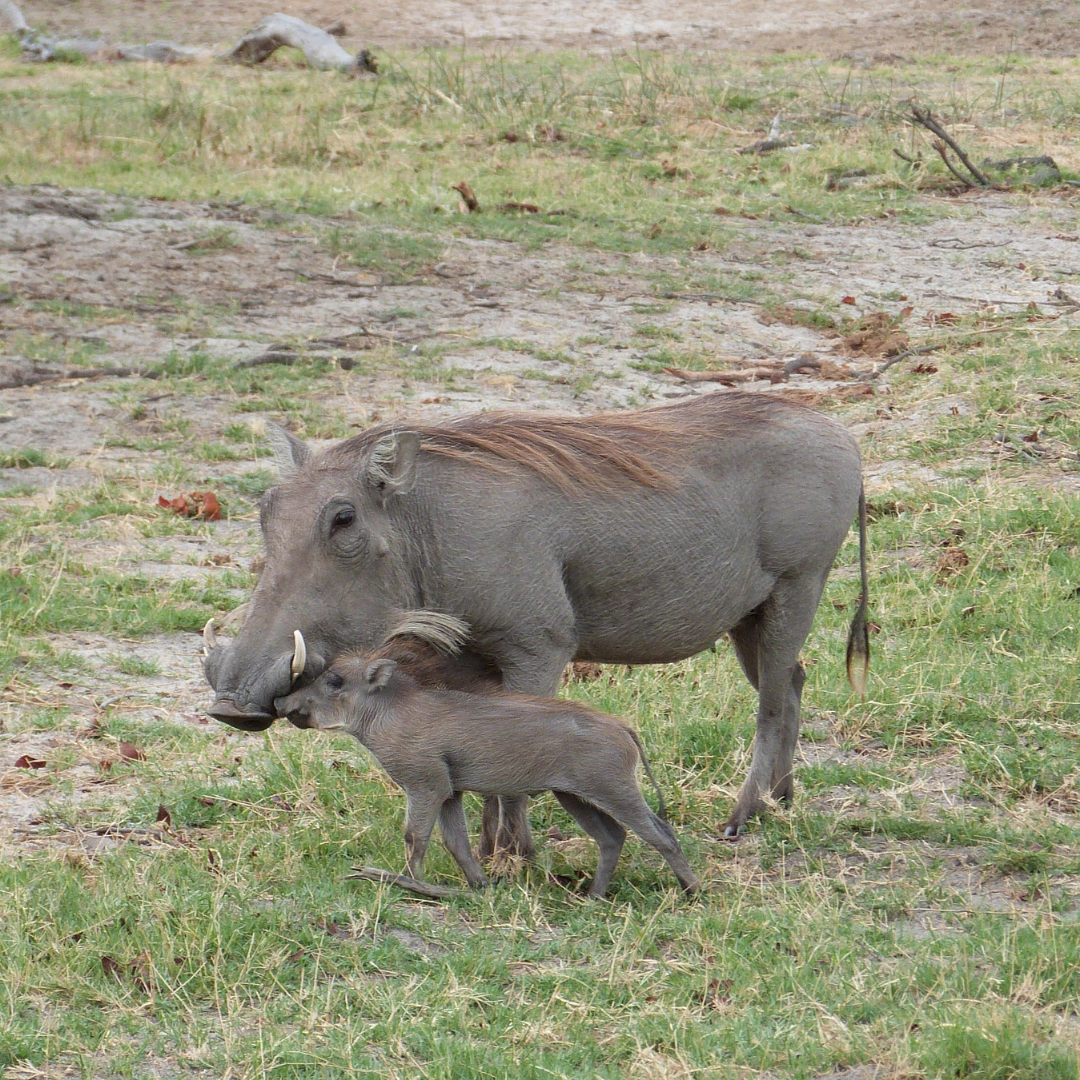Lion in camp...
“Lion! Lion!” I heard John shout, and the next thing I knew, I heard footsteps running and the car door beneath me slam shut.
I was in the rooftop tent, just reading, as it had been raining most of the day, so we’d stayed put whilst the rain thundered down.
At a slight break in the weather John had gone outside, and then I heard him shout.
Excited, and thinking that he meant that he could see one across the river, I looked out of the tent window – we usually had quite good views from up on top of the car… [Continued after highlights section]
Grateful for: making this time to experience such wild places in depth
Writing this from: Kasane, in north east Botswana near the four borders
Food highlight of the week: I’ve taken to making pancakes for brunch when we get back from a morning drive. Takes ages but is worth it – especially accompanied by Nutella!
Best moment: seeing a herd of over 100 elephants for the first time
Lowest moment: the flies at Ihaha camp one day. I had to resort to using my head net. They were dreadful.
Smallest but most pleasure from: watching a small warthog chase its tail
We’re glad that we brought: the vehicle fan, it’s making getting to sleep a lot easier
Wildlife encounter of the week: errrm, the lions?!
Fact of the week: burning elephant dung apparently keeps mosquitos away – we’re yet to try this, but there’s plenty of it about!
Recommendation for other travellers: Mogotho Khwai Community Camp – an almost perfect location on the banks of the river
[cont] “Where?” I shouted down, as I couldn’t immediately see one.
“Right there, on the path!” came John’s voice from the car.
And there, about 7 metres from the car, emerging into my view from behind a bush, on the path that we had been using to walk up to the toilet block and go to look at scenes on the river, was a lioness. And then another following it.
She stared at the car and the tent, intently. Clearly following where John had come back to the car and where our voices were coming from. …
I videoed them (to be uploaded soon, when I can), and watched as they slowly padded around as the rain began drizzling again. They were SO close. Just earlier we’d been discussing possibly going over to the water’s edge and walking a little way along. We’d seen elephants very close, wandering through the camp site and were wary of them, but had never considered the possibility of lions. And certainly not in the middle of the day – they are usually active in the early morning and evening.
One lion hid behind a bush as the other approached and then playfully pounced on the other. I then watched as she wandered round to our side of the bush and then lay down.
“Brilliant”, my voiceover on the video can be heard to say. “They’re just going to sit here, and I’m going to be trapped”, knowing that lions often sit for hours and hours on end, and that if they did, I wouldn’t be able to leave the tent.
Thankfully, after a few minutes, they wandered off.
When we reconvened – I went down into the car to talk to John – he told me that he had literally been stood on the path where they walked down, when the first one appeared around the corner from behind the bush, about 7 metres away from him.
“It was so close I could see the tiny hairs on its chin”. He said. “I decided that as I was about the same distance from the car, I would dash back, so I did, watching over my shoulder as I did”.
I hadn’t realised that he had been so close, the thought was quite scary.
“But you’re not supposed to run from a lion!” I replied. All the advice states that this is the last thing you should do as it can trigger their hunting instinct and they might chase you as potentially prey. But, to be fair, if I’d been that close to a lion, I would probably have done the same.
John’s video commentary is slightly different to mine! As I was worried about just being stuck up in the tent, and quite excitedly watching them as I felt safe up in the tent, he was understandably a little shaken and sat in the car with the doors firmly locked – just in case lions suddenly had learnt how to use car door handles!
It’s a really interesting reminder of our instincts, and the behaviour that we perform when we’re scared or think we’re under threat. What we do isn’t always ‘logical’ – of course lions can’t open car doors, and all commercial safari vehicles don’t even have doors for the passengers, they are open sided – but when the world’s largest cat is metres from your face, your instinct takes over.
We were staying at the incredibly beautiful Khwai Community Camp in the Moremi area of Botswana. Moremi and Chobe National Parks/Game Reserves are the big names that you hear of when you read about Botswana. Vast areas of truly wild land, populated by thousands of elephants, huge prides of lions and almost every other exciting and beautiful African animal you can imagine.
We’d planned to stay at a mix of the sites within the national park areas and other sites just outside (the National Park campsites are incredibly expensive, as Botswana deliberately pursues a policy of high-cost, low-volume tourism, to try and help preserve the precious natural habitat and the creatures that live here).
This site was particularly lovely – our pitch was just a few steps from the river, and the day we arrived an enormous elephant had been bathing just a few metres away.
However, on speaking to the camp guardian later that day, the track we had seen the lions on (and we saw another lion later that day) is apparently the main track that they use to move around the area, and they’re part of a large pride that was based slightly further north. We asked if we should perhaps not walk to the toilet block, and he agreed it was best to drive - all of which we thought could have been useful information to impart to us when we initially arrived!
Campsites here are nothing like we might imagine from the UK or other countries – sometimes in the UK there can be tens, if not hundreds, of people in huge sites at popular coastal resorts, with everything from one-man tents to caravans and motorhomes – it is almost entirely opposite here.
You need a 4 wheel drive vehicle to enter and drive around the parks, and there are usually only between six to a dozen individual pitches. Usually, in the national park sites, there is an ablutions block with toilets and showers, and you might also get a BBQ (or braai) area, perhaps another surface to prepare food and cook on, and other independent sites you might just get a pitch and that is all. As the locations are so stunning, as long as you are prepared, the lack of facilities in places really doesn’t matter – we were coming for the wild, not a fancy campsite resort!
Due to the currently odd times that we are all in, and it being the low season (due to the rains that start around December), we have seen very few other people. Even in the ‘hot spots’. Sometimes we have been the only campers on the site, other times there have been maybe four other groups (of usually just two people).
John, in particular, had never really wanted to go on ‘safari’ as such, due to the scenes that we’ve seen of twenty or thirty vehicles clustered around one or two animals in some parks in other countries – everyone trying to get the shot and the animals relatively nonchalant as they are so habituated to people.
So, we are delighted to have a very different experience to that. At night, waking up when hippos come grazing through your campsite (very noisily – in the still of the night their munching is extremely loud!) – hearing lions roaring, impala barking, elephants grunting, growling and trumpeting, and of course, the dawn chorus as the birds begin the day.
We’ve now spent three weeks or so travelling through the Moremi and Chobe National Parks and surrounding areas. We’ve had buffalo come grazing right up to our table in a very chilled out fashion (we leapt into the car anyway, just to be on the safe side – buffalo, especially lone ones, can be extremely dangerous); baboons – a real nuisance – leaping into the back of the car in search of food and trying the raid the rubbish bins at night; we also had a honey badger trying to get into our bin in the middle of the night; monkeys stealing our biscuits; a huge herd of buffalo come down to cross the river adjacent to where we were sitting and having our dinner, hippos chasing our boat, and, in Chobe, the incredibly beautiful sight of huge herds of literally hundreds of elephants coming to the river to bathe and then roll around in mud baths …having the opportunity to see all of this so close is truly astounding.
Which is one of the reasons that camping in these places and not just having a day trip into the park every day adds so much to the experience. As many will know, often a great deal of patience is needed to see wildlife, and it does exactly as it chooses – we can’t just order the things we’d like to see and then they turn up! (Sadly, as we’re still waiting for a leopard sighting!)
When you camp, you’re so much closer. You have so much more time in the environment. You get the unexpected thrills, and, usually, you’re not sharing it with anyone else other than the people you are with. That moment is yours and yours alone – others might have similar but those close moments are unique to you.
We’ve also made sure to take enough time in each place. We have met people who are whizzing through, spending one night in each site and trying to tick off a list of things in a very short space of time. Of course, if you have much less time than we do (and many do), it’s hard to choose what to do, but – with all travel experiences, I think – spending longer in a smaller area and really seeing it properly is often more rewarding than dashing through. Because we’re lucky with how much time we have, we have tried to spend at least three nights in each site – and it’s still been tiring sometimes because of the need to pack away (especially with a roof top tent) before you drive anywhere.
There is also the driving element to factor in. We chose Penelope for her capabilities, which we’ve been delighted to put to the test properly out here and she hasn’t let us down. The roads can consist of anything including deep mud; ‘tarmac’ with extremely deep, large and frequent potholes; seemingly endless teeth-loosening corrugations; deep, thick sand; extremely rocky and steep sections followed by fairly reasonable conditions.
And once again, the concentration required to drive these tracks and the unknowns adds more time that we need to take each day. The speed limit in the national park areas is 40km per hour – the chance would be a fine thing! Often it’s a slow crawl of not more than 20kms an hour or less – which of course, is required to see all the incredible wildlife, so it’s not a hardship (unless it’s a particularly featureless and wildlife-sparse stretch of track!)
We have taken a lot of joy in the less ‘exciting’ creatures, some of them smaller, they are all so fascinating to watch if you sit and take the time – observing the behaviour of any animals is such a joy. I absolutely adore giraffes – their patterns and funny expressions and the way they gently amble through the landscape belying how vicious they can be when they fight each other – the scars that we have seen on some as evidence of this. I watched a warthog and a tiny baby warthog foraging and it was so entertaining – the baby was just like a small puppy, chasing its tail and running about with frenetic energy; and the various types of mongoose are also extremely cute and entertaining. Although the very beginning of the rainy season can make it more difficult to spot some wildlife, it feels even more rewarding when we do, and there are a lot of newborn animals around.
As lucky as we feel to be experiencing this and as truly incredible as it all is, it's most certainly been challenging in some ways, and tedious and testing in others – and we’ll share more about the ‘lowlights’ in another post.
For now, after three weeks of exploring this stunning region, it’s off to Namibia. We’re excited to experience a new and very different country, where we’ll be spending Christmas. Enjoy all the preparations and festivities at home/wherever you are and there’ll be more from us soon.
P.S. If you’d like to receive notifications when the next adventure blog is up you can sign up here
